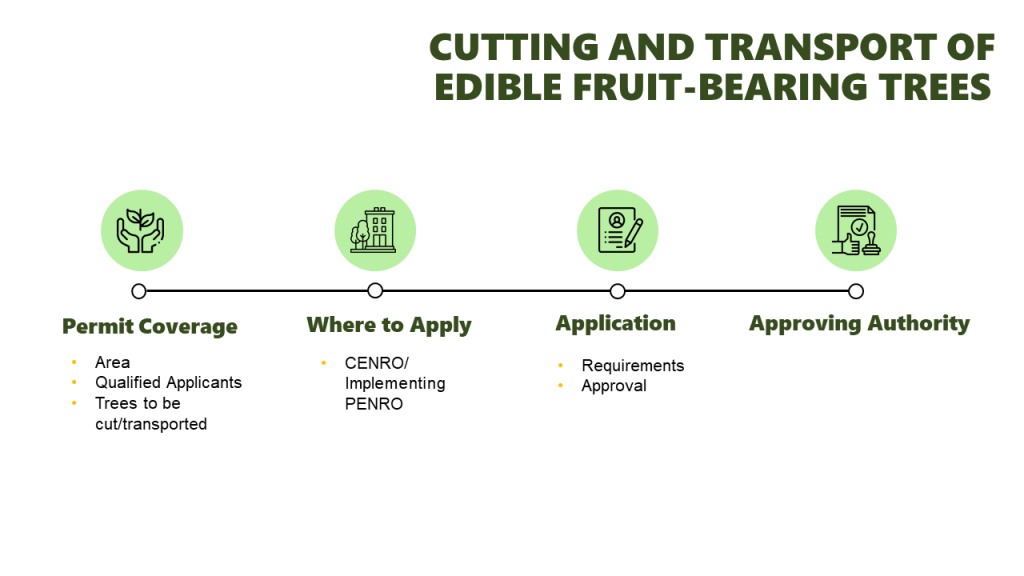| Main Governing Policies | DENR Administrative Order No. 1994-07, DENR Administrative Order No. 1994-18, DENR Administrative Order No. 2000-21, DENR Memorandum Order No. 2012-02, DENR Administrative Order No. 2016-07, DENR Administrative Order No. 2021-11 |
| Area [7] [9] [18] | Public/Forest Lands and Private lands |
| Permit/Certificate to be Issued [9] [18] | Tree Cutting Permit
Certificate of Timber Origin/Certificate of Lumber Origin |
| Qualified Applicants [9] [18] | Land Tenure Instrument Holder, and Private Title Land Owners |
| Trees [7] | Naturally grown edible fruit-bearing trees |
| Fruit-bearing Trees Covered [7] | - Eugenia Spp. (Tampoy, Makopa, Yambu, etc.)
- Euphoria didyema (alupag); E. gracelis (Boboa)
- Mangosteen
- Pili
- Balobo
- Baluno
- Bulala
- Gumihan
- Marang
- Nangka or Langka
- Lanzones
- Kamagong or Mabolo
- Alupag-amo
- Paho or Pahutan
- Guava or Bayabas
- Durian or Dulian
- Others, the fruits of which can be used as food for human being and wildlife
|
| Authority to Cut [7] | For edible fruit-bearing trees within public/forest lands
- The cutting, gathering and utilization of edible fruit-bearing trees inside forest lands may be allowed, provided that the same is in accordance with the approved Integrated Annual Operations Plan or the Comprehensive Management and Development Plan, as the case may be
|
| Cutting Requirements [7] [18] | - Please refer to documentary requirements for naturally growing trees within private lands in DAO No. 2021-11
- Certificate from the Secretary, Department of Agriculture or his duly authorized representative that the edible fruit-bearing trees(s) applied for may be cut
|
| Transport Procedure [6] | Transport Document: Certificate of Timber Origin/ Certificate of Lumber Origin (CTO)/CLO)
- Transporting logs/timber/flitches/lumber is automatically coordinated by the origin CENRO/Implementing PENRO to the destination CENRO/Implementing PENRO, which is inherent to the nature of the issued applicable permits (Tree Cutting, Lumber Dealer, Wood Processing, etc.) through the fastest possible means available, i.e., phone call, email, or fax, while also notifying the DENR Regional Office concerned of the shipment.
- The DENR Regional Office concerned shall then encode the details of shipment into the CTO and CLO system in six (6) sets, which includes among others, kind and serial number of CTO and CLO issued to a particular client, date of issuance and validity period, date of loading, point of loading, type and plate number of conveyances, name and address of client to whom the forms are issued, name and address of the final consignee, final point of loading, route, volume, and species.
|
| Approving Authority [13] |
-
For PLTP – DENR Undersecretary for Field Operations
- For Certificate of Timber Origin/Certificate of Lumber Origin – CENRO or DENR Regional Executive Director (in case of NCR)
|
| Responsibility of Permittee [21] | The replacement ratio for cut or relocated trees shall be 1:100 for naturally growing trees; and 1:50 for planted trees |
